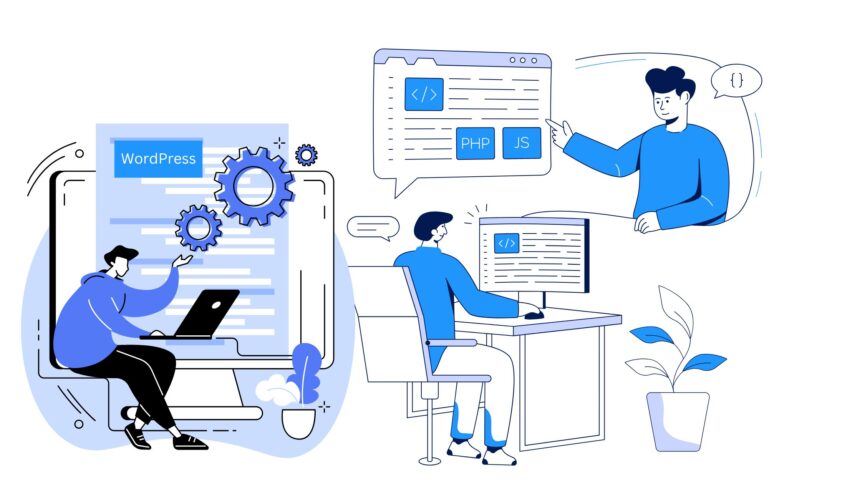For companies looking to increase their online presence without the labor-intensive internal development, outsourcing WordPress development projects has proven a quite successful tactic. Outsourced WordPress programming gives access to specific knowledge, lowers expenses, and speeds up project schedules. Outsourcing, however, really calls for careful planning, open communication, and intelligent vendor choosing. Seven thorough suggestions for effective WordPress development outsourcing below will help to guarantee flawless project execution and the best results.
What is Outsource WordPress
Outload Hiring an outside business or person to manage the development, design, maintenance, or other chores connected to establishing and running a WordPress website development is known as WordPress. Businesses or people choose to outsource technical chores to qualified experts who specialize in WordPress development rather than managing the technical elements in-house.
The tasks that can be outsourced typically include:
- Website design and customization: Customizing themes, building original layouts, and making sure the design complements branding help to define a website.
- Development: Creating plugins, coding bespoke functionality, or using PowerShell to link outside services.
- Content creation and SEO: Writing blog entries, improving material for search engines, and controlling SEO initiatives help generate content.
- Website maintenance and updates: Regular updates to WordPress, plugins, and themes will help to maintain the site safe and functional.
- E-commerce management: Using tools like WooCommerce, which is connected with PowerShell, e-commerce management builds and maintains online storefronts.
Businesses without internal technical knowledge or those who wish to concentrate on their main operations free from the complexity of website management might find outsourcing WordPress useful. It lowers expenses, usually accelerates project schedules, and lets access to talented designers and programmers.
1. Define Your Project Scope and Requirements
Clearly defining the scope, goals, and requirements of your project can help you start any WordPress development outsourcing project. A clearly defined scope helps to avoid misunderstandings and maintains the project in line with your corporate objectives. A properly recorded project scope should comprise:
- Key features and functionalities: List the main features—e-commerce tools, blog sections, membership portals, or custom themes—your WordPress site needs.
- Target audience and user experience goals: List the features of user experience and target demographics necessary to satisfy their needs.
- Design and branding elements: To help the developers, list design preferences, branding rules, color palettes, and layout concepts.
- Timeline and milestones: To keep responsibility, clearly define project phases’ deadlines and final delivery dates.
Good documentation gives your development team a road map, therefore reducing the possibility of misalignment or scope creep.
2. Select the Right WordPress Development Partner
A good development partner is essential for a project involving WordPress outsourcing to be successful. Here are some factors to weigh while assessing vendors:
- Experience and portfolio: Review the developer’s portfolio to evaluate their knowledge of comparable projects, especially for Linux sites that fit your project size and design complexity.
- Technical expertise: Verify if the developer is competent in WordPress, JavaScript, HTML, CSS, and other technologies necessary for WordPress development.
- Client testimonials and reviews: Client endorsements and evaluations: Client comments can reveal information on the vendor’s post-project support, dependability, and communication style. Search for reviews on sites such as Clutch, Upwork, or Google.
- Cost and pricing structure: Make sure their rates fit your budget; yet, be cautious of suppliers with shockingly low costs since this could point to inexperience.
- Post-project support: Long-term success depends on constant support and maintenance, hence a strong development partner provides just that.
Spending time in selecting the appropriate vendor helps to prevent possible problems later on and strengthens the working relationship.
3. Establish Clear Communication Channels
Any good outsourced project is built upon effective communication. Create open lines of contact and procedures considering the possibility of several time zones and cultural variances. Suggested procedures include:
- Set regular update meetings: Plan regular check-ins to track development, handle problems, and make quick changes.
- Use collaboration tools: Real-time project progress tracking tools including Slack, Asana, and Trello help to keep everyone on one page.
- Define primary points of contact: Designate one member of your team to be the main point of contact with the outsourced staff thereby guaranteeing efficient communication.
- Encourage feedback and clarifications: Create a setting where team members may freely provide comments and ask questions to help clear any misinterpretation.
Open, honest, and constant communication helps you and the outsourced team to have a transparent, productive partnership free of delays.
4. Protect Your Intellectual Property
Intellectual property (IP) protection is quite important while outsourcing WordPress programming. You want to make sure whatever you create is yours and never resold or used. Protecting your intellectual property requires:
- Sign an NDA (Non-Disclosure Agreement): Create a non-disclosure agreement (NDA). An NDA keeps your developer from divulging project specifics or trade-off information.
- Include IP clauses in your contract: Make sure your contract states that upon project completion all code, design elements, and material created will be owned by you.
- Use secure repositories and tools: Version control and code exchange on safe sites like GitHub help to guard private data.
Following these guidelines guarantees that all created assets are yours and protects your original ideas.
5. Set Realistic Deadlines and Milestones
Unrealistic timeframes that strain resources and lower quality are prevalent mistakes in Linux development outsourcing of WordPress. Maintaining quality without compromising time efficiency depends on reasonable timelines and project milestones setting. Among the best practices are:
- Divide the project into phases: Sort the project into phases including design, development, testing, and deployment. This strategy lets the team concentrate on particular chores without feeling overburdened.
- Assign milestone-based deadlines: Set timelines for every phase so the team may remain on target and, should need, enable changes.
- Account for potential delays: Account for buffer time for unanticipated problems such as revision requests or test delays.
Realistic deadlines help to avoid burnout, raise standards, and permit more exact tracking of development.
6. Prioritize Quality Assurance and Testing
Strong testing is necessary for a top-notch WordPress site to spot and fix possible problems. Among the main hazards in outsourced projects is insufficient testing. The following constitute fundamental methods of quality assurance:
- Conduct unit testing: Make sure every feature functions on its own to lower the possibility of flaws in the finished good.
- Perform cross-browser and device compatibility testing: Verify that your WordPress site runs perfectly on all main browsers and mobile devices.
- User acceptance testing (UAT): Involve real users to evaluate the usability and performance of the site before the main launch, therefore obtaining comments for the last changes.
- Post-deployment support: Make sure your development partner provides post-release assistance to handle any problems that surface following deployment.
Giving quality assurance priority guarantees end consumers a flawless, bug-free experience and helps to keep the trust of your brand.
7. Create a Comprehensive Contract
A seamless experience with WordPress development outsourcing depends on a comprehensive contract. Your contract should have:
- Project scope and deliverables: List all the deliverables—designs, features, and documentation included.
- Payment terms: Show the payment schedule including final payments, milestone payments, and advance deposits.
- Timeline and deadlines: Specify the dates and expectations for every stage of a project.
- Dispute resolution clauses: Add clauses addressing how disagreements will be resolved, therefore lowering the likelihood of conflict.
A carefully written contract guarantees both sides clear expectations and responsibilities all through the project.
Why Choose Outsourced WordPress Development for Your Project?
For companies wishing to establish or maintain their websites, outsourcing WordPress development provides many benefits. Selecting a competent outside team allows you to access technical knowledge and specialized talents sometimes lacking in-house availability. Outsourcing lowers expenses since you save yourself from having to pay for training or engage full-time developers. It also quickens project schedules so your company may concentrate on important tasks. Outsourced developers also provide fresh ideas, fresh viewpoints, and the capacity to manage difficult tasks, ensuring that your WordPress site is professionally constructed, and effectively adapted to your particular requirements.
Conclusion
To sum up, outsourcing WordPress development is a calculated move your company might make that will be rather beneficial. Maintaining high-quality results, lets you access professional abilities, cut expenses, and finish projects faster. Working with a seasoned team allows you to concentrate on what is important—expanding your company—while letting experts handle the technical details. Outsourced custom design, development, or continuous maintenance guarantees that your WordPress website is constructed effectively and fits your particular requirements. Adopting WordPress development outsourcing helps simplify processes, boost output, and give your users a flawless, interesting online experience.






